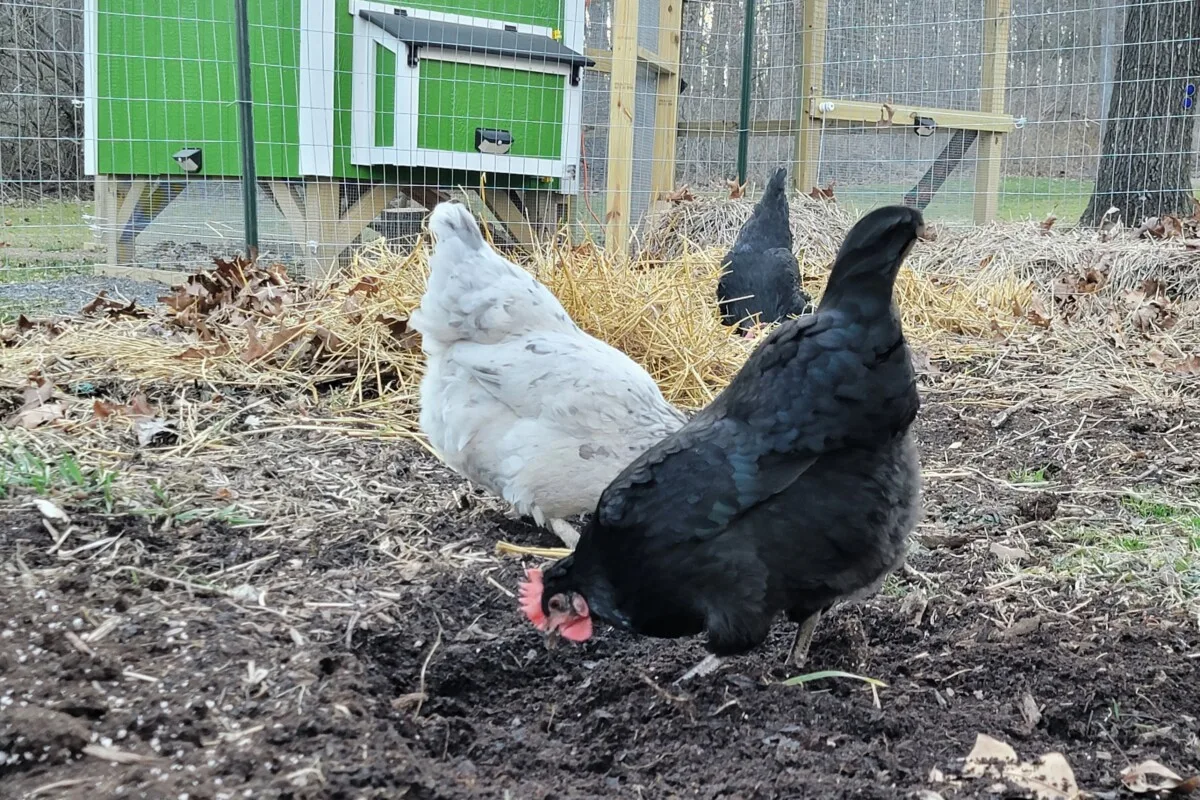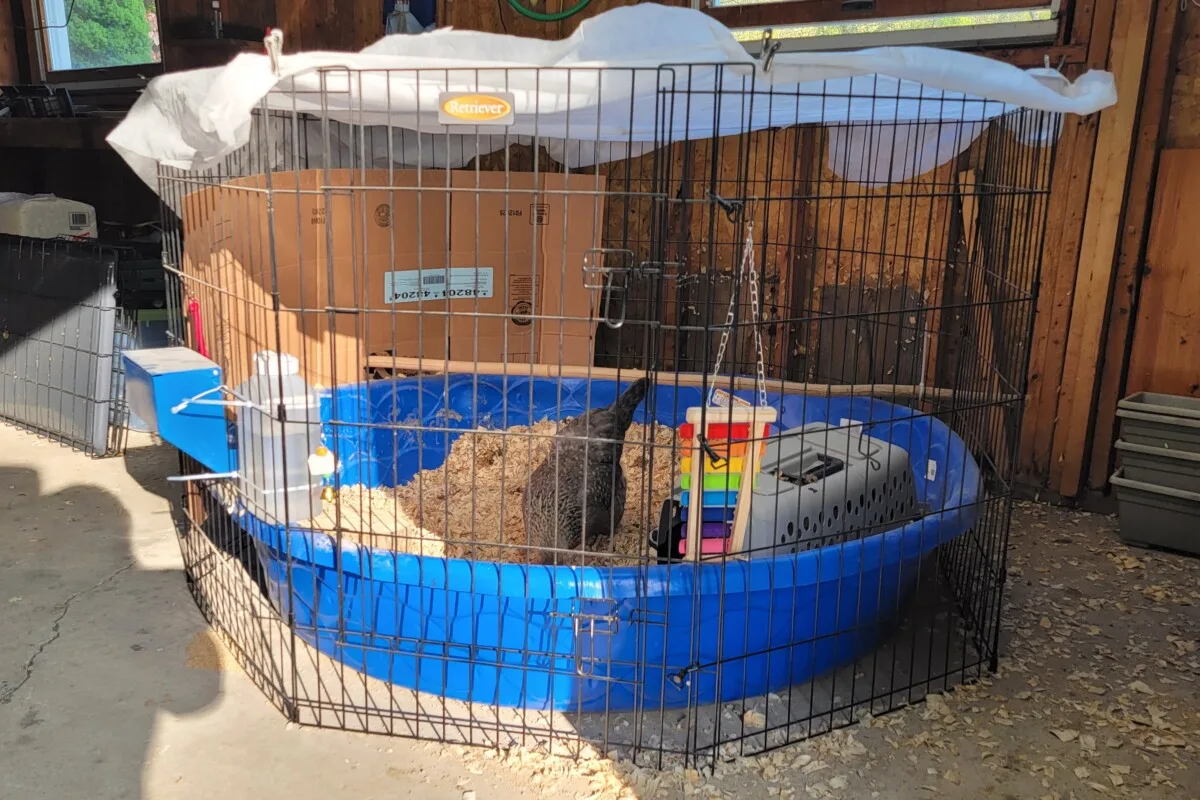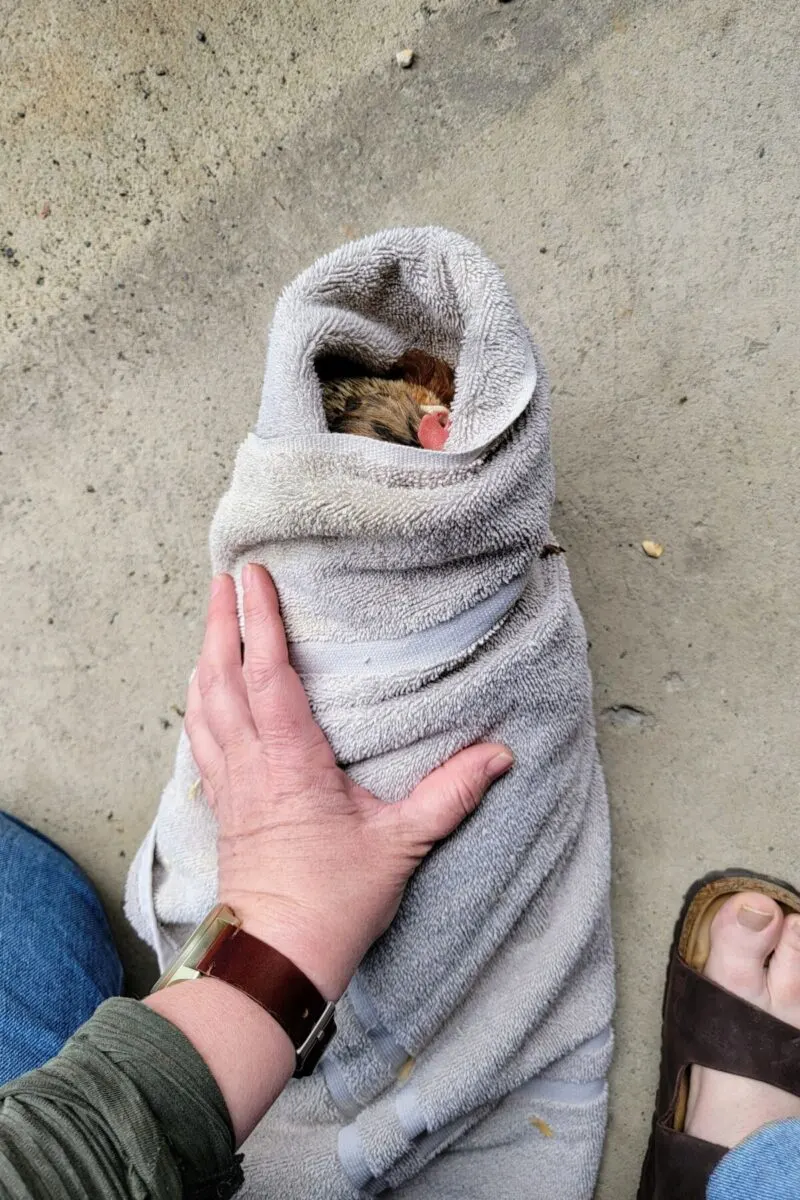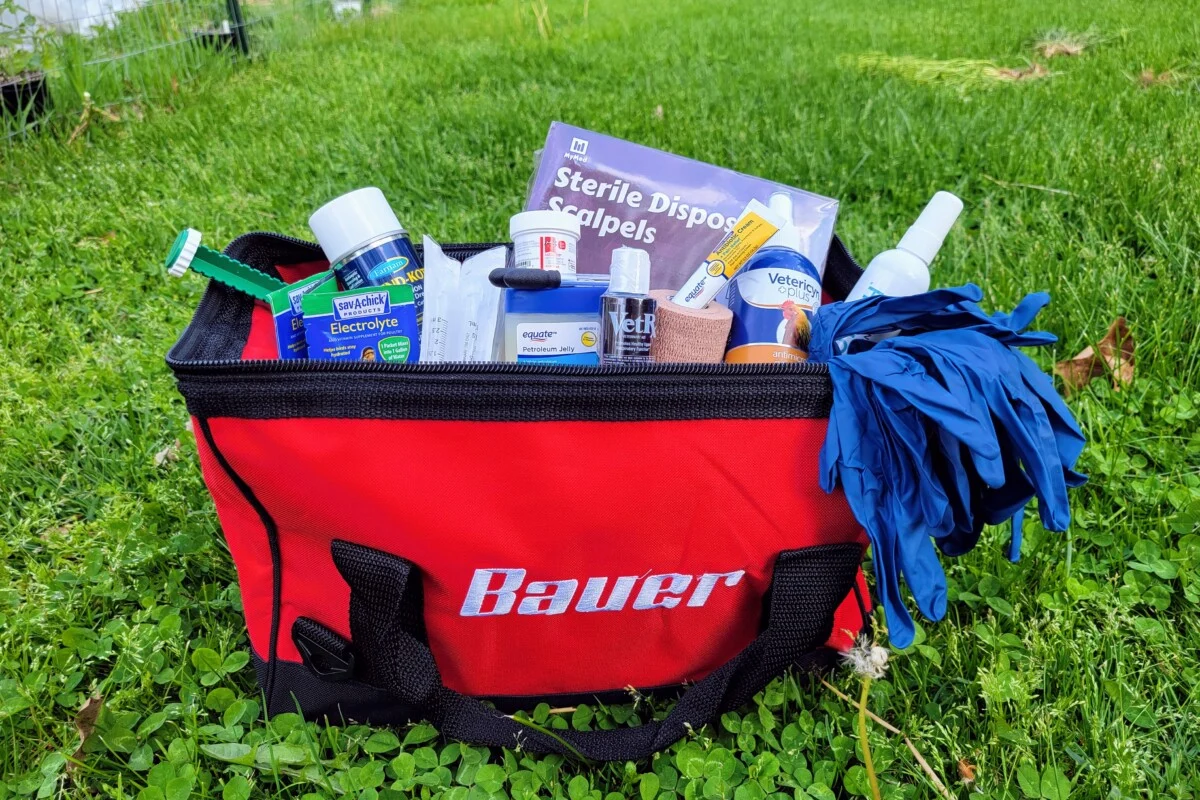
If you’ve got chickens, you already know they’re curious little buggers. You’ll often find them where you don’t want them, like in your flower bed or under the neighbor’s bird feeder. They have a knack for mischief, and it’s only a matter of time before one becomes sick or injured. Rather than running to the feed store or hoping Amazon will arrive in time, be prepared now. Create a first aid kit for your birds, so you’ll be ready when you need it.
Protecting Your Chickens
As a responsible backyard flock owner, it’s up to you to manage your chickens’ health and safety.

It’s hard to think of our sweet girls as livestock, but at the end of the day, that’s what they are. Ask any farmer, and they will tell you livestock are prone to all manner of disease and injury. Chickens are no exception.
Because of the nature of flock dynamics, and the fact that they are easy prey, chickens are masters at hiding illness until they’re very sick. Often, by the time you notice a sick bird, time is of the essence. Taking the time to assemble a proper first aid kit can be the difference between saving or losing a member of your flock.
Find a Vet Before You Need One
If you don’t already have one, it’s a good idea to look into finding a vet that treats chickens. When you’ve got a sick chicken on your hands, that’s not the time to be calling around trying to find someone who treats poultry and is accepting new patients. Establish that relationship before you need them. You’ll be glad you did.
Finding a vet that treats poultry can be difficult, depending on what area of the country you live in. In that case, it’s even more important to have a proper first aid kit for your chickens. Backyard chicken-keeping forums and YouTube are great resources for figuring out chicken illnesses and how to treat them, but only if you have the right tools on hand.
A Practical Note
This information does not constitute veterinary advice. If you’re concerned about your chickens and how to treat them, you should consult your nearest avian veterinarian.
Where Will You House Sick Birds?
It’s important to have a small chicken “hospital” ready to go if you need it. Chickens will need to be isolated from the rest of the flock to allow them time to heal and rest without being hen-pecked and to protect the rest of your flock if your bird is contagious.
You’ll want to keep them someplace quiet, sheltered and dark to minimize their distress.
An old dog crate, a pet carrier, or even an extra-large cardboard box can work to contain your chicken and keep them comfortable while they heal.

This is Olivia, a new bird who is in quarantine before we integrate her with our existing flock.
It’s a good thing we quarantined her too; we discovered she had whipworm shortly after we got her.
Now that you’ve got that on your to-do list, let’s look at what you’ll need for a well-stocked chicken first aid kit.
First Aid Supplies
Gloves

Gloves are more than just a matter of hygiene; they offer a layer of biosecurity that can help protect the rest of your flock from contagions. You don’t need the whole box of gloves in your first aid kit. Tuck several pairs into your kit and replace them as you use them.
Clean Towel

A clean towel always comes in handy. Chicken first aid can be a messy affair. But towels are also great for covering a stressed-out chicken, so she’s in the dark. Or you can use the towel to “burrito” a chicken that needs to be immobilized for care or administering medication.
Coffee Filter and Super Glue
If a bird injures its beak, and the beak is still attached, you can use a coffee filter and super glue to glue the separated pieces back together carefully. Extreme care must be used around the bird’s nostrils, tongue, etc.
Disposable Scalpels

Not for the squeamish, but sometimes these come in handy.
Vaseline
Hit up the travel-size section at Target and get yourself a tiny tub of Vaseline. It’s great for protecting combs during cold weather, dealing with mites and even for an egg-bound hen.
Self-Adhesive Bandage Wrap or Vetrap

Vetrap is a name brand for that funky-looking gauze that sticks to itself. It’s the same stuff they use on your arm when you have a blood draw. Self-adhesive bandage wrap is great for binding wounds or keeping gauze pads in place without sticking to feathers or skin.
It comes in 1”, 2”, and 4” wide rolls. The 2” is the perfect size for dealing with chickens.
Oral Syringes

If you need to give oral medications, having a small oral syringe with markings on it makes it easy to measure doses. And don’t forget to be careful when administering oral medicines to chickens.
Medicine Droppers

These are great for washing out eyes or administering eye drops. You can use them to apply medications to the skin as well as for treating mites or worms.
Headlamp

Skip the flashlight and invest in an inexpensive headlamp. Trust me; you need as many hands as you can get when dealing with a sick bird.
Scissors

Having a small but sharp pair of scissors that you only use for your birds is wise. Store them in your first aid kit, and you won’t have to worry about finding a pair when working on a stressed-out chicken.
Non-stick Gauze Pads

Use these much as you would for a person, to cover and protect wounds and sores as they heal. You’ll want to use the self-adhesive bandage wrap to keep the gauze in place. It’s always a good idea to buy larger pads than you think you’ll need. You can always trim the smaller if you need to.
Important Phone Numbers
Put the phone numbers of your local avian vet, your state’s poultry pathology lab, and the USDA avian flu hotline (866-536-7593) on an index card and keep it in your first aid kit. It’s also not a bad idea to put those numbers in your cell phone.
Medicine & Treatments
Treats
A spoonful of sugar helps the medicine go down, and as anyone with a toddler knows, bribery is often the best way to get a squirmy patient to sit still. Keep a small handful of cracked corn or dried black soldier flies larva in a zip-top baggie in your first aid kit.
Vitamin & Electrolyte Mix

Stressed new chicks, heat stroke, diarrhea, there are a number of reasons to have a few packets of electrolyte solution on hand. It’s one of the first things we do for our birds when we think something is up.
Vetericyn Spray

Vetericyn spray is probably the most valuable bottle in your entire kit as it’s so useful. Make sure you purchase the formulation for chickens; it’s also safe to use on chicks. This is a general-purpose first-aid spray meant for all types of wounds and sores. Unlike other treatments, Vetericyn has no egg withdrawal period. (Set time you need to dispose of/not use the eggs from the treated bird.)
Blu-Kote

Blu-Kote is an anti-pecking first aid spray. This is great for when you have an, ahem, especially amorous rooster or if there’s been general hen-pecking among the group. This antibiotic spray turns the wound purple (blue + red = purple), which will help camouflage wounds or sores. Chickens like the color red and will peck at anything red. The Blu-Kote lets the wound heal, hidden under a blue antibiotic layer. Fair warning – this stuff will stain your hands and clothes.
Neosporin First Aid Ointment

Go easy with Neosporin and save it for when you can be sure there is a bacterial infection. Antibiotics are overused, creating antibiotic-resistant strains of bacteria. Too often, folks reach for this without being sure if bacteria is present first.
Nutri-Drench

Like Sav-a-Chick, Nutri-Drench is a vitamin packed electrolyte solution that’s a good boost for any chicken under the weather. This is one of those that’s good to start with when you aren’t exactly sure what’s wrong.
Styptic Powder

Styptic powder. It stops bleeding. Fast. (It’s a good thing to have in any first aid kit, chicken or otherwise.)
Epsom Salts
Epsom salts are great for a soothing soak for bumblefoot or an egg-bound hen. Itchy hens getting over a mite infestation will also appreciate a soothing soak. Use plain Epsom salts rather than scented varieties.
Permethrin Dust

Use this dust to eliminate mites and other creepy crawlies that might make your girls uncomfortable. You can sprinkle it directly on your bird and around their run, and inside the coop. Make sure you store it (and your first aid kit) somewhere dry.
Aspirin
Be sure to purchase the non-coated kind. Aspirin can help a chicken in pain be more comfortable.
Chlorhexidine Solution (2%)

Use this for cleaning and sterilizing wounds. It’s less harsh than hydrogen peroxide (which can kill healthy cells).
Storing Your Chicken First Aid Kit

It’s a good idea to keep everything in a box specifically for this purpose. You can get fancy and pick up an inexpensive toolbox or tool bag, or repurpose one of those cardboard Amazon boxes you’ve got lying around. The idea is to have everything you need in one spot, so you can grab it and go.
Keep your supplies in a cool, dark place and check expiration dates on medications and first aid products at least once a year. Replace out-of-date items as needed. Change the batteries in your headlamp once a year as well.
You will add new things to your first aid kit as you find what you need or use most. You may find a brand or certain products that work better than others. Or you may find you just don’t need certain items. Whatever the case, being prepared before you have a sick chicken is the goal.

Get the famous Rural Sprout newsletter delivered to your inbox.
Including Sunday ramblings from our editor, Tracey, as well as “What’s Up Wednesday” our roundup of what’s in season and new article updates and alerts.

